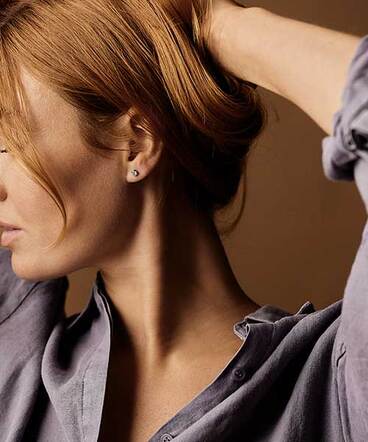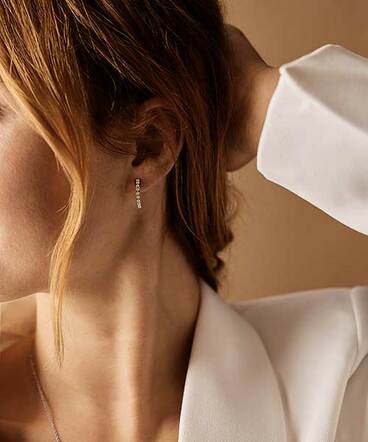Men and jewellery through history
Men and jewellery through history

In the past century, women may not have had the monopoly on wearing jewellery, but they have certainly been significantly overrepresented. Recently, however, we have seen growing interest in jewellery among men, be they artists, actors or sports stars, and ‘regular guys’ in particular.
No matter what your preferred style is, here at Blomdahl we think everyone should be able to wear attractive jewellery made using skin friendly materials. Which is why we have produced a collection that we think will appeal to a wide range of men.
The fact that men are increasingly wearing jewellery may seem like a modern trend, but history shows just the opposite. Men began wearing jewellery long before women – to elevate their status, as protective talismans, and to bring good luck.
Men have always worn jewellery
The Neanderthals were the first humans to use accessories. Historians believe that they may have made the world’s first pieces of jewellery around 130,000 years ago, by stringing together animal teeth and shells.
The Egyptians, circa 5,000 years ago, adorned themselves as a way of safeguarding their future. The more silver and gold jewellery they wore, the more attractive they thought they would be to the gods who had power over health, wealth and the afterlife.
In ancient Greece, soldiers wore jewellery into battle. Metal and leather cuffs were an attempt to ensure spiritual protection during battle – a practice also followed by ancient Roman troops.
It was British royalty during the Tudor period who started the trend for wearing heavy gold chains, while precious stones were seen as a status symbol. For a period, it was only rich men of high rank in the church who were allowed to wear them. Henry VIII’s jewel box was found to contain at least 230 rings, 320 brooches and countless necklaces.
During the 16th and 17th centuries, a popular trend among men in Europe was to wear a single earring – often a large drop pearl earring. Pirates and mariners during the 18th century wore jewellery as a form of life assurance. A gold earring would pay for their burial, and there was a code of honour of sorts which stated that such an earring should be used for that purpose alone and not be pocketed instead.
The 20th century, and WWII in particular, had a considerable impact on the wearing of jewellery among men, which has continued to this day. Traditionally, it was only women who wore a wedding ring. However, with being away for such a long time during the war, men wanted something to remind themselves of home and the loved ones waiting for them, and so they began wearing a plain gold ring on their left hand. This trend continued after the war, and since the 1950s most married men have chosen to wear a wedding ring.
The following decades have seen various fashions come and go, such as the long necklaces of the hippy era, large gold medallions in the 70s, eye-catching stones in the 80s, and a flirtation with dog tags and chunkier steel and titanium pieces in the 90s.
Trendsetters like Johnny Depp and David Beckham championed a slightly more extravagant look during the early 2000s. Today, stars such as Harry Styles, Machine Gun Kelly, Jaden Smith and Timothée Chalamet have continued along the same lines. At the same time, this is counterbalanced by a more minimalist look. A good example of this is the simple silver chain worn by the character Connell in the hit TV series Normal People. So popular did the necklace become that it even has its own Instagram account with almost 150,000 followers!
The Egyptians, circa 5,000 years ago, adorned themselves as a way of safeguarding their future. The more silver and gold jewellery they wore, the more attractive they thought they would be to the gods who had power over health, wealth and the afterlife.
In ancient Greece, soldiers wore jewellery into battle. Metal and leather cuffs were an attempt to ensure spiritual protection during battle – a practice also followed by ancient Roman troops.
It was British royalty during the Tudor period who started the trend for wearing heavy gold chains, while precious stones were seen as a status symbol. For a period, it was only rich men of high rank in the church who were allowed to wear them. Henry VIII’s jewel box was found to contain at least 230 rings, 320 brooches and countless necklaces.
During the 16th and 17th centuries, a popular trend among men in Europe was to wear a single earring – often a large drop pearl earring. Pirates and mariners during the 18th century wore jewellery as a form of life assurance. A gold earring would pay for their burial, and there was a code of honour of sorts which stated that such an earring should be used for that purpose alone and not be pocketed instead.
The 20th century, and WWII in particular, had a considerable impact on the wearing of jewellery among men, which has continued to this day. Traditionally, it was only women who wore a wedding ring. However, with being away for such a long time during the war, men wanted something to remind themselves of home and the loved ones waiting for them, and so they began wearing a plain gold ring on their left hand. This trend continued after the war, and since the 1950s most married men have chosen to wear a wedding ring.
The following decades have seen various fashions come and go, such as the long necklaces of the hippy era, large gold medallions in the 70s, eye-catching stones in the 80s, and a flirtation with dog tags and chunkier steel and titanium pieces in the 90s.
Trendsetters like Johnny Depp and David Beckham championed a slightly more extravagant look during the early 2000s. Today, stars such as Harry Styles, Machine Gun Kelly, Jaden Smith and Timothée Chalamet have continued along the same lines. At the same time, this is counterbalanced by a more minimalist look. A good example of this is the simple silver chain worn by the character Connell in the hit TV series Normal People. So popular did the necklace become that it even has its own Instagram account with almost 150,000 followers!
Comfortable jewellery to suit all styles
No matter what your style, what really matters is that you feel comfortable. As a well-known fashion photographer put it:
“Style is about confidence and wearing what feels natural. If you’re not comfortable wearing it, it probably won’t look good, so stick to jewelry that is within your comfort zone.”
Men can have slightly thicker wrists and wider throats and necks, which is why some of our styles are larger and use longer links. But everything is a matter of taste. Provided you think something is attractive and works for you, wear it! If it’s also kind to your skin and of good quality, then you can wear it as often and for as long as you want. A piece of jewellery from Blomdahl ticks all the right boxes.
“Style is about confidence and wearing what feels natural. If you’re not comfortable wearing it, it probably won’t look good, so stick to jewelry that is within your comfort zone.”
Men can have slightly thicker wrists and wider throats and necks, which is why some of our styles are larger and use longer links. But everything is a matter of taste. Provided you think something is attractive and works for you, wear it! If it’s also kind to your skin and of good quality, then you can wear it as often and for as long as you want. A piece of jewellery from Blomdahl ticks all the right boxes.





 Sweden
Sweden  Denmark
Denmark  Germany
Germany  Spain
Spain  Austria
Austria  For English
For English